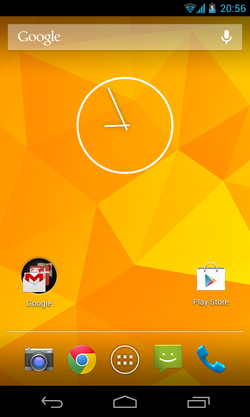User experience
Visually, Jelly Bean's interface reflects a refinement of the Holo appearance introduced by Android 4.0. [19] The default home screen of Jelly Bean received new features, such as the ability for other shortcuts and widgets on a home screen page to re-arrange themselves to fit an item being moved or resized. The notification system was also improved with the addition of expandable and actionable notifications; individual notifications can now display additional content or action buttons (such as Call back or Message on a missed call), accessible by dragging open the notification with a two-finger gesture. Notifications can also be disabled individually per app. [20]
Android 4.2 added additional features to the user interface; the lock screen can be swiped to the left to display widget pages, and swiped to the right to go to the camera. A pane of quick settings toggles (a feature often seen in OEM Android skins) was also added to the notification area— accessible by either swiping down with two fingers on phones, swiping down from the top-right edge of the screen on tablets, or pressing a button on the top-right corner of the notifications pane. The previous Browser application was officially deprecated on 4.2 in favor of Google Chrome for Android. 4.2 also adds gesture typing on the keyboard, a redesigned Clock app, and a new screensaver system known as Daydreams. On tablets, Android 4.2 also supports multiple users. [7] [16] [19]
To promote consistency between device classes, Android tablets now use an expanded version of the interface layout and home screen used by phones by default, with centered navigation keys and a status bar across the top. These changes took effect for small tablets (such as the Nexus 7) on 4.1, and for larger tablets on 4.2. Small tablets on Android are optimized primarily for use in a portrait (vertical) orientation, giving apps expanded versions of the layouts used by phones. When used in a "landscape" (horizontal) orientation, apps adjust themselves into the widescreen-oriented layouts seen on larger tablets. On large tablets, navigation buttons were previously placed in the bottom-left of a bar along the bottom of the screen, with the clock and notification area in the bottom-right. [21] [22] [23]
For developers, 4.1 also added new accessibility APIs, expanded language support with bi-directional text support and user-supplied keymaps, support for managing external input devices (such as video game controllers), support for multichannel, USB, and gapless audio, a new media routing API, low-level access to hardware and software audio and video codecs, and DNS-based service discovery and pre-associated service discovery for Wi-Fi. Android Beam can now also be used to initiate Bluetooth file transfers through near-field communication. [23]
Android 4.2 added a rewritten Bluetooth stack, changing from the previous Bluez stack (GPL created by Qualcomm) to a rewritten Broadcom open source stack called BlueDroid. [24] [25] The new stack, initially considered "immature" [26] promised several forward-looking benefits, [24] including improved support for multiple displays, support for Miracast, native right-to-left support, updated developer tools, further accessibility improvements such as zooming gestures, and several internal security improvements such as always-on VPN support and app verification. [23] A new NFC stack was added at the same time. [24]
Android 4.3 consisted of further low-level changes, including Bluetooth low energy and AVRCP support, SELinux, OpenGL ES 3.0, new digital rights management (DRM) APIs, the ability for apps to read notifications, a VP8 encoder, and other improvements. [18]
Android 4.3 also included a hidden privacy feature known as "App Ops", which allowed users to individually deny permissions to apps. However, the feature was later removed on Android 4.4.2; a Google spokesperson stated that the feature was experimental and could prevent certain apps from functioning correctly if used in certain ways. [27] [28] The concept was revisited as the basis of a redesigned permissions system for Android 6.0. [29]

